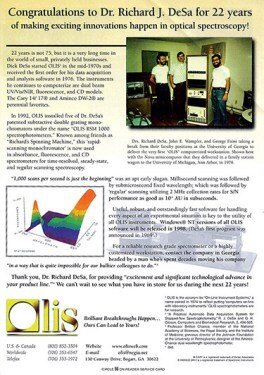Fascination About Circularly Polarized Luminescence
Fascination About Circularly Polarized Luminescence
Blog Article
Getting My Uv/vis/nir To Work
Table of ContentsUv/vis/nir for DummiesNot known Facts About Circularly Polarized LuminescenceSpectrophotometers Things To Know Before You BuyNot known Facts About Circular DichroismCircular Dichroism Fundamentals Explained

Spectrophotometry is a tool that hinges on the quantitative analysis of particles depending on how much light is taken in by colored compounds.
Spectrophotometers for Dummies
A spectrophotometer is typically utilized for the measurement of transmittance or reflectance of options, transparent or nontransparent solids, such as polished glass, or gases. Numerous biochemicals are colored, as in, they absorb visible light and therefore can be measured by colorimetric procedures, even colorless biochemicals can frequently be converted to colored compounds suitable for chromogenic color-forming reactions to yield substances ideal for colorimetric analysis.: 65 Nevertheless, they can also be developed to measure the diffusivity on any of the listed light varieties that generally cover around 2002500 nm using different controls and calibrations.
An example of an experiment in which spectrophotometry is used is the determination of the balance constant of an option. A specific chain reaction within a solution might take place in a forward and reverse instructions, where reactants form products and products break down into reactants. At some time, this chain reaction will reach a point of balance called a stability point.
The 3-Minute Rule for Spectrophotometers
The quantity of light that passes through the solution is a sign of the concentration of particular chemicals that do not enable light to travel through. The absorption of light is due to the interaction of light with the electronic and vibrational modes of molecules. Each kind of particle has a specific set of energy levels associated with the makeup of its chemical bonds and nuclei and hence will absorb light of particular wavelengths, or energies, leading to special spectral residential or commercial properties.
They are extensively used in many industries consisting of semiconductors, laser and optical manufacturing, printing and forensic evaluation, as well as in laboratories for the study of chemical compounds. Spectrophotometry is often used in measurements of enzyme activities, decisions of protein concentrations, determinations of enzymatic kinetic constants, and measurements of ligand binding reactions.: 65 Eventually, a spectrophotometer is able to figure out, depending on the control or calibration, what substances are present in a target and exactly how much through estimations of observed wavelengths.
This would come as a solution to the previously created spectrophotometers which were not able to soak up the ultraviolet properly.
The Main Principles Of Uv/vis/nir
It would be discovered that this did not give acceptable outcomes, therefore in Model B, there was a shift from a glass to a quartz prism which enabled better absorbance outcomes - UV/Vis/NIR (https://disqus.com/by/julieanndesalorenz/about/). From there, Model C was born with an adjustment to the wavelength resolution which wound up having 3 units of it produced
It irradiates the sample with polychromatic light which the sample absorbs depending upon its homes. It is transmitted back by grating the photodiode variety which discovers the wavelength area of the spectrum. Ever since, the production and application of spectrophotometry gadgets has increased immensely and has actually turned into one of the most ingenious instruments of our time.

An Unbiased View of Spectrophotometers
The grating can either be movable or fixed.
In such systems, the grating is repaired and the intensity of each wavelength of light is determined by a various detector in the selection. When making transmission measurements, the spectrophotometer quantitatively compares the fraction of light that passes through a reference service and a test option, then digitally compares the intensities of the 2 signals and computes the percentage of transmission of the sample compared to the recommendation standard.

Report this page